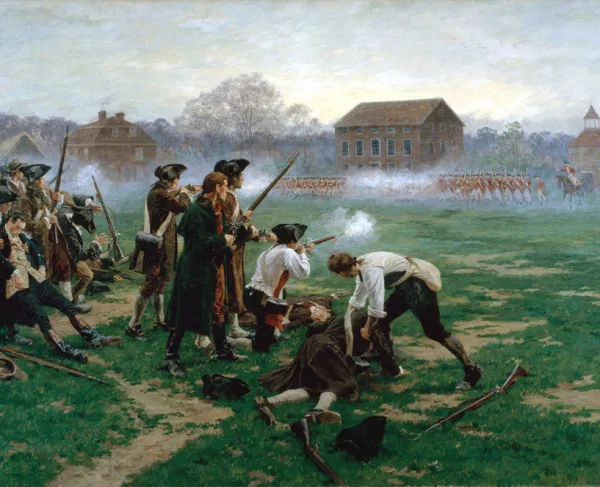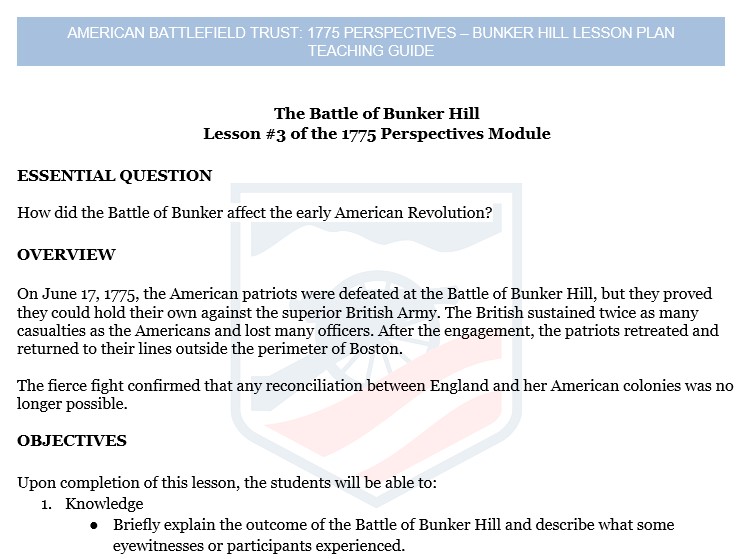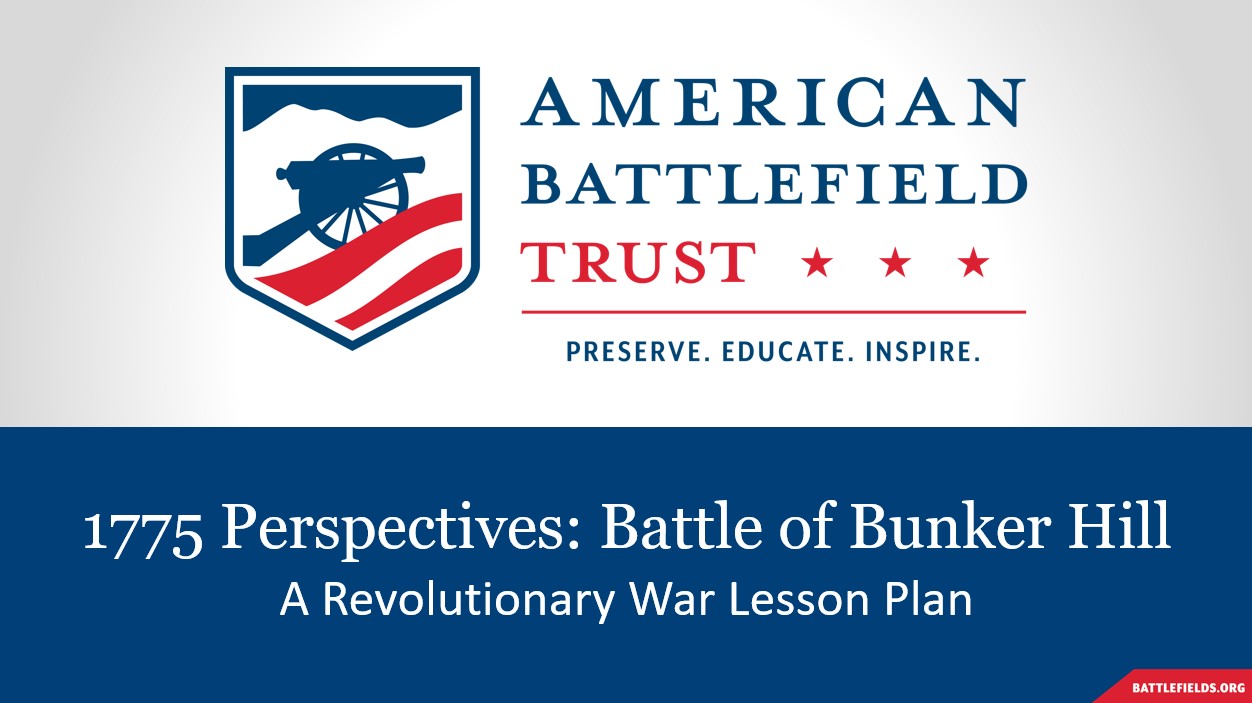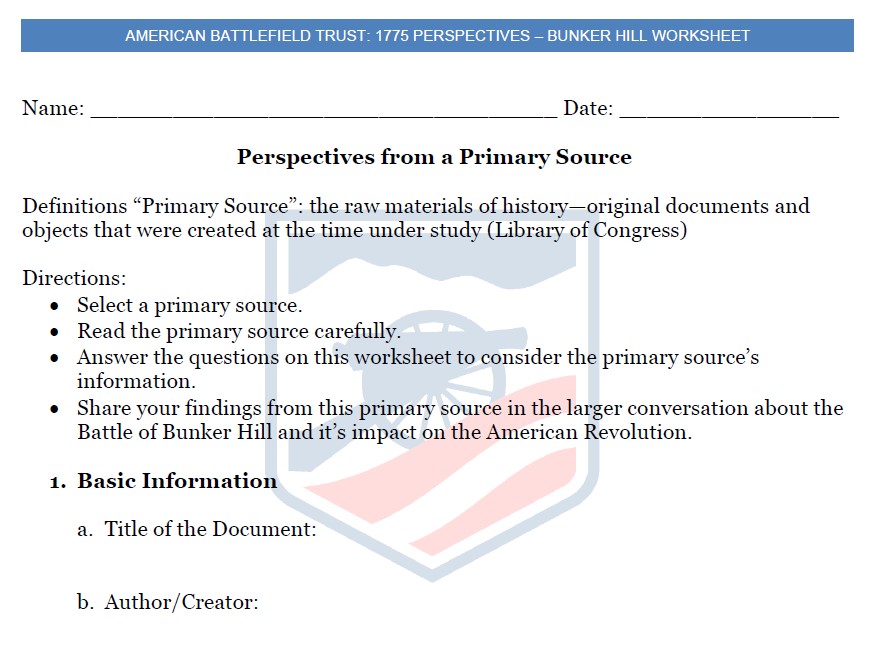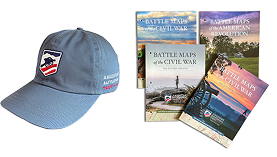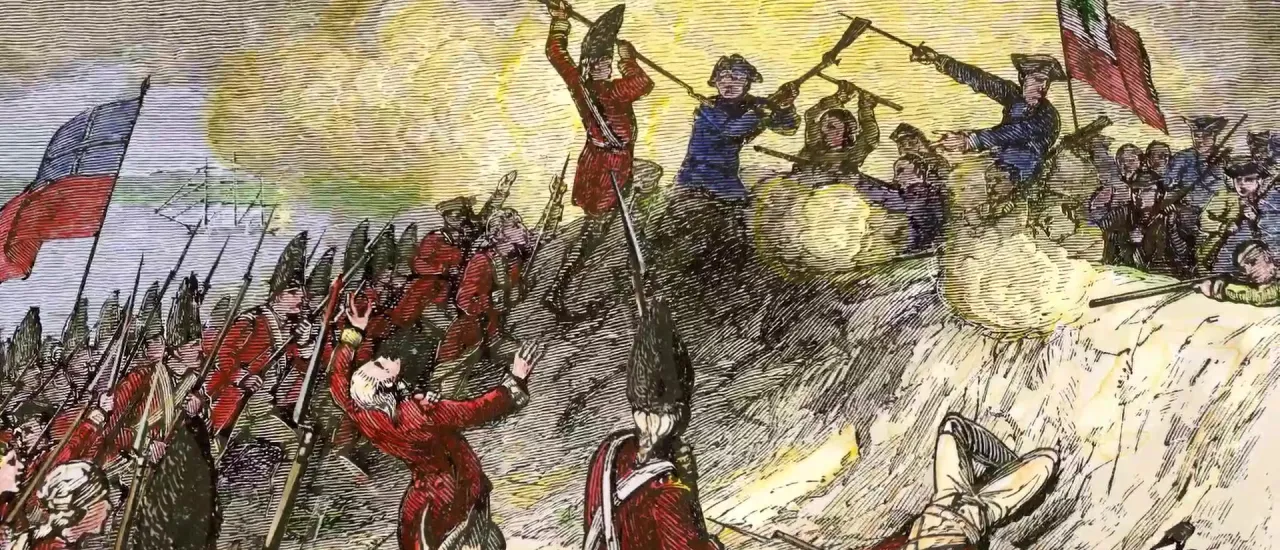
Bunker Hill: 1775 Perspectives Lesson Plan
A lesson plan for use in middle and high school classrooms.
On June 17, 1775, the American patriots were defeated at the Battle of Bunker Hill, but they proved they could hold their own against the superior British Army. The British sustained twice as many casualties as the Americans and lost many officers. After the engagement, the patriots retreated and returned to their lines outside the perimeter of Boston.
The fierce fight confirmed that any reconciliation between England and her American colonies was no longer possible.
This Lesson Plan can be used as a prepared resource by following this curriculum plan which aligns to NCSS and Common Core Standards.
This Lesson Plan's assets can also be used on their own as supplemental resources. The display format is prepared for easy access, exploring, and learning.
1775 Perspectives Module
Upon completion of this lesson, the students will be able to:
- Knowledge
- Briefly explain the outcome of the Battle of Bunker Hill and describe what some eyewitnesses or participants experienced.
2. Comprehension/Application/Analysis
- Examine multiple primary sources to gain perspectives on the battle and its outcomes.
3. Evaluation
- Discuss findings from primary sources and how the Battle of Bunker Hill influenced the American Revolution.
Check out the Lesson Plan Teaching Guide for more instructions on using the prepared Lesson Plan.
Lesson Plan Primary Source Activity:
- Use the Lesson’s PowerPoint to explore the context and history; the PowerPoint introduces context and foundational knowledge of the Battle of Bunker Hill.
- The primary sources for this perspectives lesson plan offer multiple perspectives from different people who fought or observed the battle; students can be divided into groups to read and fill out the worksheet.
| British | 1775: "In His Majesty's Name, Offer and Promise, His Most Gracious Pardon" |
| British | Bunker Hill: "Very Fatal to the 1st Battalion of Marines" |
| British | Bunker Hill: "To Acquaint Your Lordship of an Action on the 17th" |
| American | Bunker Hill: "We Entrench'd & Made a Fort" |
| American | Bunker Hill: "My Brother was Missing" |
| American | 1775: "Dr. Warren...Fell Gloriously Fighting For His Country" |
| American | “1775: The Committee of Safety’s Account of The Battle of Bunker Hill |
| American | Dedication Speech for the Unveiling of the Bunker Hill Monument |
- Distribute the lesson’s worksheet.
- Students will read a primary source and fill out the worksheet which will guide them through exploring the document.
- Encourage a class discussion from the worksheet, draw group conclusions, answering the questions:
- Who won the Battle of Bunker Hill? Depending on who wrote a particular document, what reasons were given for the outcome of the battle?
- What were some reactions to the Battle of Bunker Hill in these primary sources?
- What did people think would happen next after the Battle of Bunker Hill?
- What have you heard about the Battle of Bunker Hill? Does it seem to be a verifiable history fact or a legend?
OPTIONAL HOMEWORK/ASSESSMENT/ADDITIONAL ACTIVITIES:
Option 1: Joseph Warren’s Death
Joseph Warren, a prominent leader in the Sons of Liberty and in Massachusetts, was killed during the Battle of Bunker Hill. Explore the reports and reactions to his death as people memorialized him as an early “martyr” of the American cause.
- Joseph Warren (short biography)
- Bunker Hill: "My Brother was Missing"
- 1775: "Dr. Warren...Fell Gloriously Fighting For His Country"
- 1775: The Committee of Safety’s Account of The Battle of Bunker Hill
Note how Warren was mentioned in the primary sources, then do some extra research to discover if or how he is remembered today. In their own words, invite students to summarize (written or verbally) Warren’s influence on the Revolution, even through his death.
Option 2: Sketch a Map
Using these historic and modern maps, have students sketch a map or create one digitally. Then using notes from primary sources, add callout boxes or tabs to place some primary source quotes on the mapped locations. (Examples might include Charlestown, the redoubt, the slope of Breed’s Hill, British landing places, etc.)
Common Core State Standards- ELA & History/Social Studies
Grades 6-8
- Key Ideas and Details:
- CCSS.ELA-LITERACY.RH.6-8.1
- Cite specific textual evidence to support analysis of primary and secondary sources.
- CCSS.ELA-LITERACY.RH.6-8.2
- Determine the central ideas or information of a primary or secondary source; provide an accurate summary of the source distinct from prior knowledge or opinions.
- CCSS.ELA-LITERACY.RH.6-8.1
- Craft and Structure:
- CCSS.ELA-LITERACY.RH.6-8.6
- Identify aspects of a text that reveal an author's point of view or purpose (e.g., loaded language, inclusion or avoidance of particular facts).
- CCSS.ELA-LITERACY.RH.6-8.6
- Integration of Knowledge and Ideas:
- CCSS.ELA-LITERACY.RH.6-8.8
- Distinguish among fact, opinion, and reasoned judgment in a text.
- CCSS.ELA-LITERACY.RH.6-8.8
Grades 9-10
- Key Ideas and Details:
- CCSS.ELA-LITERACY.RH.9-10.1
- Cite specific textual evidence to support analysis of primary and secondary sources, attending to such features as the date and origin of the information.
- CCSS.ELA-LITERACY.RH.9-10.2
- Determine the central ideas or information of a primary or secondary source; provide an accurate summary of how key events or ideas develop over the course of the text.
- CCSS.ELA-LITERACY.RH.9-10.3
- Analyze in detail a series of events described in a text; determine whether earlier events caused later ones or simply preceded them.
- CCSS.ELA-LITERACY.RH.9-10.1
- Craft and Structure:
- CCSS.ELA-LITERACY.RH.9-10.5
- Analyze how a text uses structure to emphasize key points or advance an explanation or analysis.
- CCSS.ELA-LITERACY.RH.9-10.6
- Compare the point of view of two or more authors for how they treat the same or similar topics, including which details they include and emphasize in their respective accounts.
- CCSS.ELA-LITERACY.RH.9-10.5
- Integration of Knowledge and Ideas:
- CCSS.ELA-LITERACY.RH.9-10.8
- Assess the extent to which the reasoning and evidence in a text support the author's claims.
- CCSS.ELA-LITERACY.RH.9-10.9
- Compare and contrast treatments of the same topic in several primary and secondary sources.
- CCSS.ELA-LITERACY.RH.9-10.8
Grades 11-12
- Key Ideas and Details:
- CCSS.ELA-LITERACY.RH.11-12.1
- Cite specific textual evidence to support analysis of primary and secondary sources, connecting insights gained from specific details to an understanding of the text as a whole.
- CCSS.ELA-LITERACY.RH.11-12.2
- Determine the central ideas or information of a primary or secondary source; provide an accurate summary that makes clear the relationships among the key details and ideas.
- CCSS.ELA-LITERACY.RH.11-12.3
- Evaluate various explanations for actions or events and determine which explanation best accords with textual evidence, acknowledging where the text leaves matters uncertain.
Craft and Structure:
- Evaluate various explanations for actions or events and determine which explanation best accords with textual evidence, acknowledging where the text leaves matters uncertain.
- CCSS.ELA-LITERACY.RH.11-12.6
- Evaluate authors' differing points of view on the same historical event or issue by assessing the authors' claims, reasoning, and evidence.
- CCSS.ELA-LITERACY.RH.11-12.1
- Integration of Knowledge and Ideas:
- CCSS.ELA-LITERACY.RH.11-12.8
- Evaluate an author's premises, claims, and evidence by corroborating or challenging them with other information.
- CCSS.ELA-LITERACY.RH.11-12.9
- Integrate information from diverse sources, both primary and secondary, into a coherent understanding of an idea or event, noting discrepancies among sources.
- CCSS.ELA-LITERACY.RH.11-12.8
Social Studies - National Council for the Social Studies
- Theme 2: Time, Continuity, and Change
- Theme 3: People, Places, and Environments
- Theme 4: Individual Development and Identity
- Theme 5: Individuals, Groups, and Institutions
- Theme 9: Global Connections
This Lesson plan
contains the following:
3 Activities | 24 Resources
Audience: Middle school | High school
